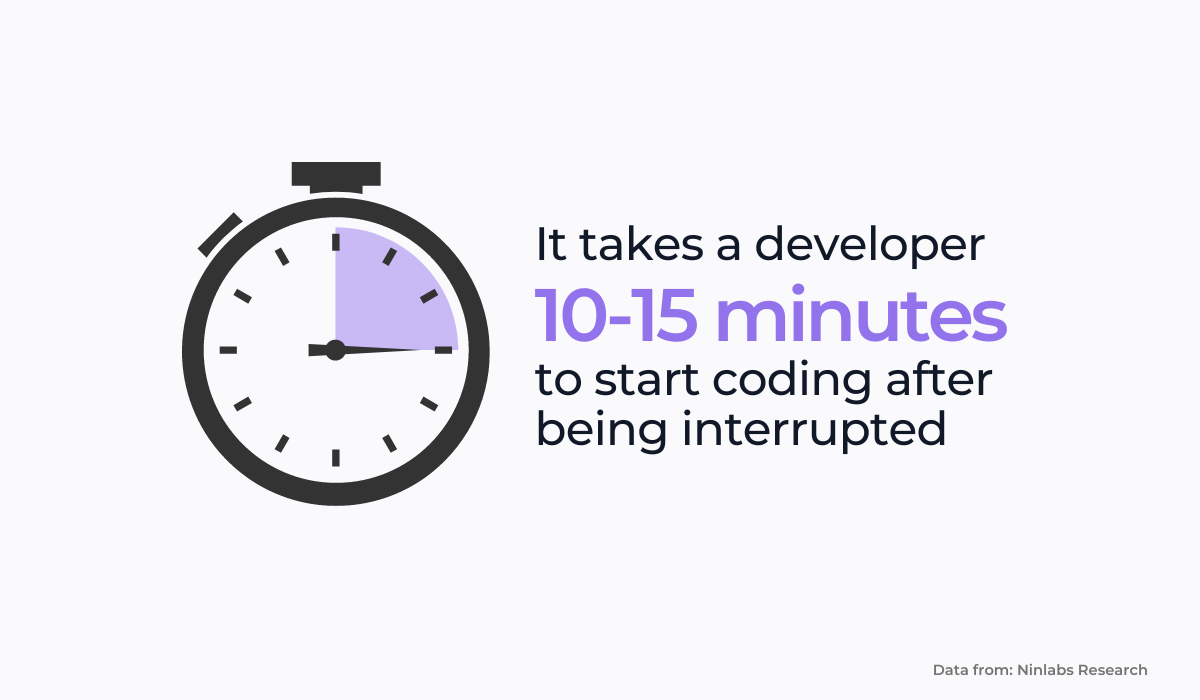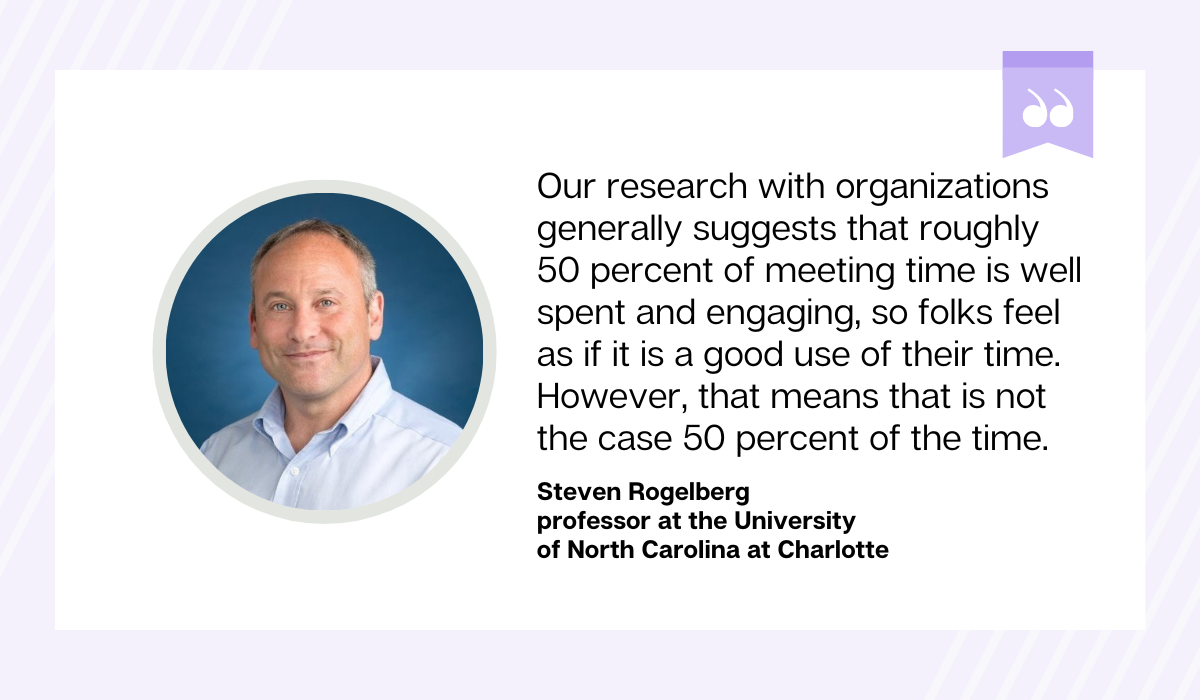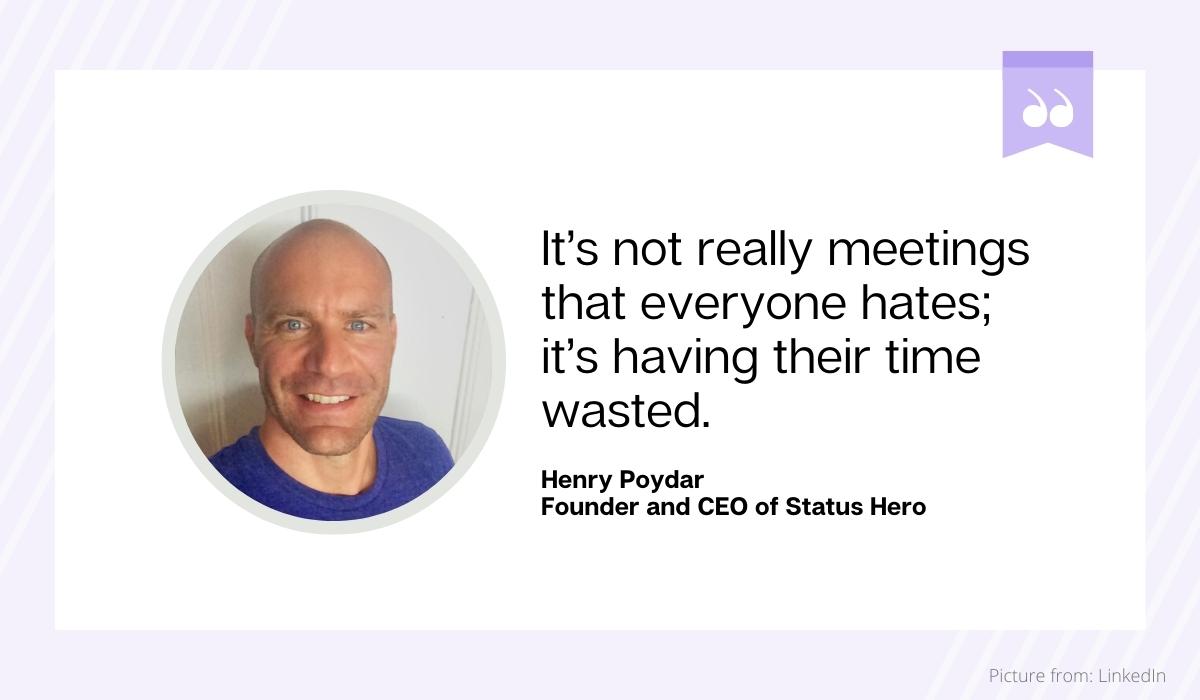
To anyone who has ever worked in software development, the following situation will probably sound familiar.
You walk into a meeting expecting it to be brief and productive, only for it to drag on for hours.
You had hoped to make some progress on a project but instead got stuck in a room listening to colleagues talk about things that are irrelevant to your work.
How would you feel about it if it happened to you?
You’d probably leave the meeting feeling frustrated and defeated, thinking about how you wasted precious time you could have spent coding.
This is just one of the many reasons why developers dislike meetings, and we list some of the most important ones in this article.
However, meetings are a fact of life in a corporate setting, so to learn how you can make your meetings better, keep reading.
Table of Contents
They interrupt the workflow
Developers tend to produce their best work when they’re fully immersed in their tasks.
When they enter that state of high focus, they don’t get distracted easily, check their emails or take calls every ten minutes, and it feels like time passes quickly.

Get unreal data to fix real issues in your app & web.
In other words, they’re in a state called flow (also known as the zone).
Flow is a psychological term coined by psychologist Mihaly Csikszentmihalyi, and it describes a mental state of extreme focus and engagement with a task.

However, when developers are pulled away from their work to go, for example, to a meeting, their flow is interrupted.
And according to Chris Parnin, a principal researcher at Microsoft, it takes developers 10-15 minutes on average to start editing code again after the interruption.

To further understand why developers don’t like meetings, it’s essential to consider the difference between a maker’s and a manager’s schedule, as Paul Graham described it in his famous essay on time management.
He believes that developers, designers, writers (and other creative types) are on the maker’s schedule—which is entirely different from a manager’s.
Managers spend a lot of their time in meetings and can easily schedule activities into 1-hour blocks.
They have multiple appointments throughout the day, and they can reschedule them at a moment’s notice, without sacrificing any productivity.
It’s a different situation for makers, who are often working on complex problems that require them to be focused and free from distraction to solve.
Because they need to work uninterruptedly for at least half a day to complete any given task, they can’t divide their work into such 1-hour intervals.
Here’s a chart that demonstrates this point perfectly.

The table clearly shows that the manager’s schedule is built around meetings.
On the other hand, when meetings interfere with a maker’s workflow, that can be incredibly frustrating for them.
As Paul Graham points out, interruptions can be disastrous for developers.
“When you’re operating on the maker’s schedule, meetings are a disaster. A single meeting can blow a whole afternoon, by breaking it into two pieces each too small to do anything hard in. Plus you have to remember to go to the meeting. That’s no problem for someone on the manager’s schedule.”
So what can be done?
According to Henry Poydar, founder and CEO of Status Hero, a good idea would be to schedule your meetings at the beginning or end of each workday. He states:
“This way, people don’t have to switch gears in the middle of work and can work without keeping one eye on the clock, careful not to miss the meeting.”
For tech employees, productivity peaks between 9 am and 1 pm—and decreases in the late afternoon.
Therefore, scheduling meetings outside those hours would be a good idea.

Regardless of how you choose to schedule meetings, try making sure that large periods of time exist in which developers can work without interruptions.
This approach tends to produce the best results.
They are too frequent
Most developers don’t like meetings because they’re called too often.
Sure, meetings are a great way to ensure everyone involved in a project understands what’s going on.
However, more often than not, team leads schedule meetings about matters that could easily be resolved via email or some other means of communication that don’t require everyone to be present.
For example, Dave King, Asana’s Head of Marketing, thinks that meetings whose sole purpose is to provide updates are a waste of time and should be avoided at all costs.

Amrit Pal Singh, a cloud software engineer at Caavo, is on the same page when he states that developers should skip the daily meetings altogether because, considering their profession, they’re pointless.
Throughout his career, he has participated in daily meetings where everyone was supposed to report on what they had accomplished since the previous day’s meeting.
He often noticed that between these two meetings, many developers didn’t manage to get much work done. He continues:
“Most of the time, the work we do is complex and that requires a few days for the outcome to show up. These daily status meetings are just a waste of time if you have to give updates about what you have done.”
He, therefore, suggests that it would be good to increase the gap between such meetings.
The question, then, is what is the most effective meeting frequency for developers?
Let’s look at GitHub’s Good Day Project research to see if we can answer this question.
Github conducted a survey among 40 software developers to discover how events at work during the day affect their productivity, stress levels, and feelings of satisfaction.
The researchers found that the days with the fewest meetings and interruptions were reported as the developers’ best workdays.
On the other hand, developers were more likely to have an unproductive day when they had many meetings.

The researchers also found that developers who had more than two meetings a day were much less likely to meet their goals.
Conversely, developers who had just one meeting per day had a 99% chance of delivering high-quality work.

Therefore, before scheduling a meeting, it would be wise to consider whether or not it’s really necessary to have everyone from your development team in the same place.
If you can’t find a way to get the information that you need without holding a meeting, it might be worth taking the time to schedule one.
However, if there’s no urgent reason for everyone to attend, consider whether or not it might be better to postpone the meeting or cancel it altogether.
As Anna Binder, Asana’s Head of People, explains, it’s basically a whole day every week intended to enable developers to focus uninterruptedly on moving the work forward.

Teams still use Slack on Wednesdays, but they try to keep their focus on the task at hand by minimizing social distractions.
Now, for most employees, Wednesday is the favorite day of the week. And the No Meetings Wednesday proved to be such a hit that the company uses it as a recruiting tool.
Asana’s example shows that when you want to ensure that developers focus on work that produces results, schedule meetings accordingly.
If developers are busy working on projects, don’t interrupt them. Give them time to complete their tasks and take care of other important matters later.
They aren’t well structured
The problem with meetings is that they too often become rambling, disorganized affairs. They lack structure–which makes them a poor use of time.
The average meeting lasts between 31 and 60 minutes.

However, considering the fact that only about 50% of that time is spent productively, as the research shows, it’s easy to see why many developers are frustrated with the current meeting model.

Another problem is that meeting attendees tend to drift away from the topic of discussion, especially if the meeting lasts longer, as the findings about attention span suggest.

This all tends to happen when there is no meeting agenda in place–a lack of structure that can lead to time wasting and inefficiency.
Even statistics back up this claim as many professionals state that if you want a meeting to be successful, it needs to have clear objectives and an agenda.

However, this isn’t always the case as reportedly, only 37% of the meetings have a pre-planned agenda.
Some developers are so averse to meetings without an agenda in place that they’ll make a special effort to avoid attending them.
Amrit Pal Singh, who we already mentioned earlier, is one of those developers who has a personal rule to avoid this kind of unstructured meeting since he claims that they tend to “drift from topic to topic and waste everyone’s time.”

He stresses the importance of having meetings that ask critical questions and result in meaningful conclusions.
And in his own words, it’s the agenda that sets the meeting’s direction and poses questions that need to be addressed.
Andrew Filev, founder and CEO of Wrike, further elaborates on this point and suggests that, in order for the meeting to be even more structured, it would be advisable for the team leads to review the agenda before the meeting starts.
“Prepare people ahead of time so you are all on the same page when you enter the room. Create notes and an agenda in advance and–here’s the tricky part–actually review them before the meeting starts.”
If you are wondering how to create an agenda for your team meeting, there are some simple ways to do it.
You can use a template from the vast resources of the internet, or you can create your own.
You can also use a tool like Monday to help you manage your team meetings and keep them organized.

The image above shows how easy it is to create a meeting agenda and share it with your team members when you have a tool that allows you to create it in just a few clicks.
That also means that there is no excuse for you to ever have a meeting without an agenda again.
If you create an agenda for your meeting and stick to it, your developers will see the value in attending meetings with you.
They are often irrelevant
Developers often get pulled into meetings about sales and marketing when they don’t have any influence in those areas or can’t contribute anything valuable.
And if there’s anything that drains an employee’s productivity, it’s a low-engagement meeting.

In low-engagement meetings, developers aren’t active participants, and they have no say in the outcome. This leads to a lack of engagement.
Atlassian has revealed some surprising facts about today’s meetings, and a few of them really stood out: employees daydream during meetings, do other work, and even fall asleep.

It’s a sad truth, but too often developers only attend meetings because they have to.
Henry Poydar, who we’ve already mentioned, puts it best when he states that the real problem with meetings isn’t the meetings themselves—it’s that people hate wasting their time in them.

So how can you make sure that your meetings aren’t a waste of time?
Here are some tips on how to run effective and relevant meetings.
First, keep the meeting short and focused. You should only have one clearly defined goal, and the meeting should end as soon as it has been achieved.
Elon Musk, for instance, has made a habit of this practice.

Furthermore, according to Donna McGeorge, author of The 25 Minute Meeting: Half the Time, Double the Impact, it’s best for a meeting to last no more than 25 minutes if you want it to be productive.
If a meeting, for instance, lasts for an hour, chances are that the discussion has gone off-topic and become irrelevant to the developers.
Twenty-five minutes is more than enough time to go through the agenda, discuss each item and come to a decision.
Before scheduling your next meeting, you can also consider the following steps to ensure that it’s worth attending for everyone involved:
- who is going to attend the meeting
- what are their biggest concerns
- what particular sections or aspects of your topic are most relevant to them
- what do you need from them
- why is it important for them to be there
That will help you determine if the meeting will be relevant for developers and whether they will have anything to contribute.
If not, consider making attendance optional.
It may be that only a portion of your meeting will be applicable to the developers.
In this case, you could still invite them to your meeting, allowing them to attend only the part that applies to them and come and go when they need to.
Conclusion
Meetings can be a great way for teams to coordinate and communicate within a company, but still, most developers think of them as just a necessary evil.
It’s easy to see why: meetings are time-consuming, often not very productive, and usually either have no real purpose or go on too long.
However, they can still be valuable tools if they’re approached correctly.
That’s why in this article, we’ve listed some of the biggest reasons why they’re so disliked among developers, as well as some tips on how to make them better.
With these pointers, you should be able to make meetings more productive and enjoyable for everyone on your team.





